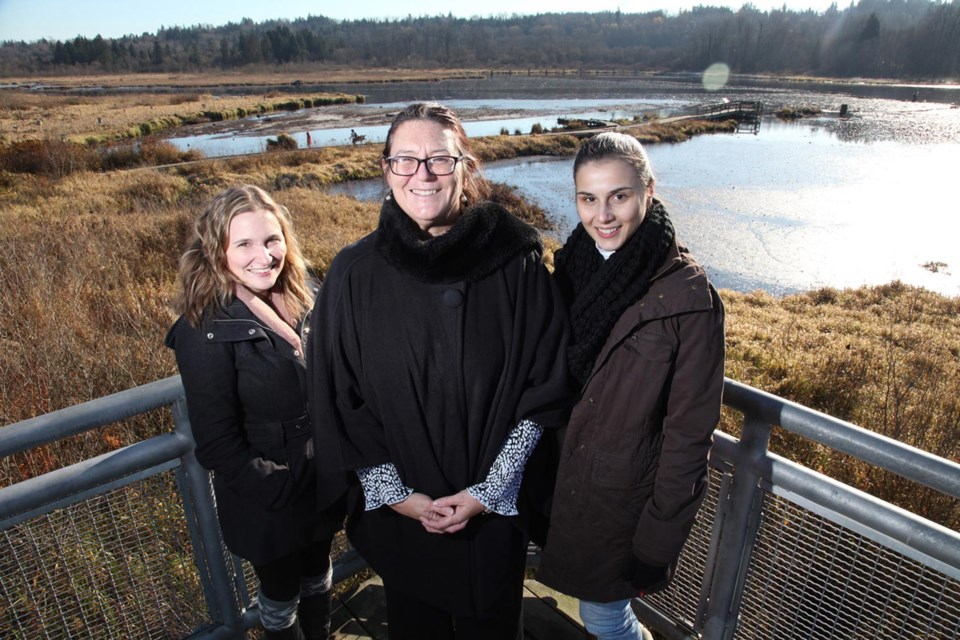A small two-person Burnaby operation is showing local kids a whole new world – and one that’s not far from home.
Since its inception 13 years ago, the Pacific Parklands Foundation has given children the key to escaping the concrete jungle.
The foundation works within 22 regional parks, raising funds for projects that improve accessibility and give youth and nature lovers more opportunities to interact with the natural world.
“It’s pretty much an escape from the city, to get away from the hustle and bustle of Vancouver and even Burnaby,” said Caitlin Hill, the communications and fund development coordinator for the foundation.
One of the foundation’s success stories is located within the city, though it seems an entirely different world from Brentwood or Metrotown – the viewing tower at Burnaby Lake Park.
On a bright, cold fall day, the two foundation staff members and their intern meet with the NOW at the park to discuss the foundation’s work.
In the distance, traffic streams past highrise buildings, but in the park, the scene is tranquil and quiet – barring the occasional train whistle.
The tower was built in 2009, after three-and-a-half years of planning, though it took only two months to build the structure.
The foundation raised $160,000 for the tower project, according to executive director Denise Coutts.
“Metro Vancouver has such a big long list of things that they need to do, so that’s where our foundation can come in and approach some of our different funders and see if they’re interested,” she said of the foundation’s fundraising efforts.
Metro Vancouver provides interpretive staff to educate students about the park, and it uses features like the viewing tower to do so, she said.
“They complement it by having interpretive staff that will meet the teacher and the class right in the park here and then take them out to the viewing tower and talk about the ducks and the painted turtles and all the different aspects of the birding boxes. All of the different components that all the kids get absolutely excited about,” she said. “And the interpretive staff are really fabulous. They dress up, they have lots of props, they have binoculars, I mean, they just have all sorts of ways of really connecting with youth. For some of them, they’ve never been in a park.”
The foundation also offers the Catching the Spirit program through four regional parks.
The program includes free camps for youth 12 to 18 years of age, providing outdoor recreation and environmental stewardship experiences.
“Many of the kids, they just haven’t had that experience of setting up the tent and cooking,” Coutts said, adding they do trail maintenance, invasive species removal and tree planting as well.
“It’s real physical work for the kids, and it’s very new to them and it’s very unique.”
Coutts, who previously worked for sports non-profits and the Minerva Foundation, said she loves her work with Pacific Parklands.
“It’s an opportunity to be outdoors and connect with my roots for recreation and healthy living,” she said.
“I like small little organizations that are great, they have a good mandate and mission. It’s just fun to start with them when they’re very small and watch them grow. I get up every day excited to come to work.
“Some of the volunteers we work with, they’ve had these dreams and visions for 10, 20, 30 years,” she added. “When you see the look on their face and the accomplishment that many hands can make happen, it’s pretty rewarding.”
The foundation is currently working on its first major capital campaign, the Kanaka Creek Watershed Centre in Maple Ridge.
The first phase of the project – rebuilding the old Bell-Irving Hatchery – was completed in April, according to Hill, and now the foundation is raising funds to build an accompanying stewardship centre.
“The idea is that it will become a sort of campus, so it’s not just the indoor component with the stewardship centre but also the activities that take place at the hatchery that youth and the public can engage in, as well as the whole outdoor environment,” Hill said, adding the park is very unique, with sandstone canyons and waterfalls.
Since the foundation began its work in 2000, they have partnered on more than 80 projects within regional parks.
Follow Janaya on Twitter, @janayafe



